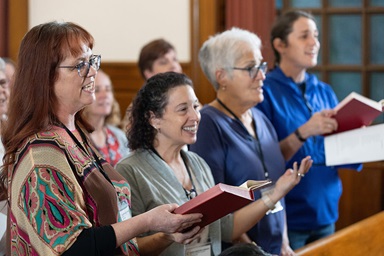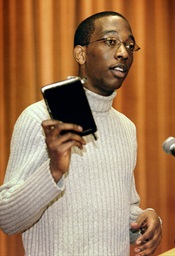African-American United Methodist churches will continue to be strengthened and revitalized for mission and ministry for another four years.
Delegates to the 2004 General Conference of the United Methodist Church decided that May 5 as they approved continuation of the Strengthening the Black Church for the 21st Century (SBC21) initiative. They also approved creation of an African-American Methodist Heritage Center.
The $2.2 million Strengthening the Black Church initiative was first enacted by the 1996 General Conference and continued by the 2000 session as a major program initiative of the denomination. Its goal is to link growing U.S. congregations with partner churches and to revitalize the more than 2,500 African-American United Methodist congregations.
SBC21 offers the denomination a model of enabling vibrant, growing congregations to share their experiences and learnings with other churches that seek growth, vitality and transformation.
Delegates continued the initiative after learning that the task of restoring, reconstructing, redeeming, reconciling, revitalizing and renewing churches for mission and ministry has not been completed.
According the legislation, new emphases for 2005-2008 will include looking for a solution to the exodus of youth and young adults from African-American churches and developing program and relationships with congregations of African descent in central conferences and other nations of the global community. The initiative also will develop curricula for training churches for ministry in the the communities in which they work and produce resources for health care, HIV/AIDS and other special needs.
“The mission of SBC21 is to make disciples of Jesus Christ,” said the Rev. Tyrone Gordon of Dallas, before the vote to continue the initiative was enacted. He told the top legislative assembly that SBC21 has “breathed new life into many churches” and “is a witness that God can bring life out of death, hope out of despair, victory out of defeat.”
In other actions, the delegates also approved an African American Methodist Heritage Center that would become a central depository of black Methodist history. The center, proposed two years ago at a national meeting of Black Methodists for Church Renewal, will collect the history, memories and stories of those of African descent who have been a part of Methodism since its inception in the mid-18th century and those of African descent who have stayed throughout Methodism’s history, said the approved legislation.
Black Methodists for Church Renewal initiated plans for the heritage center in consultation with the United Methodist Commission on Archives and History. As delegates approved the center, they established an endowment fund through the United Methodist Church Foundation. Until a permanent facility is built at one of the denomination’s historically black colleges or universities, the center will be housed at the United Methodist Commission on Archives and History at Drew University, Madison, N.J.
According to an article in the May 6 edition of the General Conference’s Daily Christian Advocate, the center anticipates linking, through Web sites and special programs, with historic institutions such as Gulfside Assembly in Waveland, Miss., and churches such as Mother African Zoar United Methodist in Philadelphia.
Delegates also were made aware of an Aug. 27-29 reunion in Atlanta of Methodists who were a part of the denomination’s former segregated Central Jurisdiction.
Between 1939 and 1968, the Methodist Church operated the Central Jurisdiction, a racially segregated, nongeographical jurisdiction for African-American churches in the denomination. The jurisdiction was created as a compromise on the issue of race when the Methodist Episcopal Church, the Methodist Episcopal Church, South and the Methodist Protestant Church merged in 1939 to create the Methodist Church. When the United Methodist Church was created in 1968 with the union of the Methodist and Evangelical United Brethren denominations, the Central Jurisdiction was eliminated. The jurisdiction's churches, clergy and bishops were assigned to the five geographic jurisdictions.
Today, there are 423,456 African-American U.S. members of the United Methodist Church, including 14 bishops.
*Green is a news writer for United Methodist News Service.
News media contact: (412) 325-6080 during General Conference, April 27-May 7.
After May 10: (615) 742-5470.
Related
Like what you're reading? Support the ministry of UM News! Your support ensures the latest denominational news, dynamic stories and informative articles will continue to connect our global community. Make a tax-deductible donation at ResourceUMC.org/GiveUMCom.



